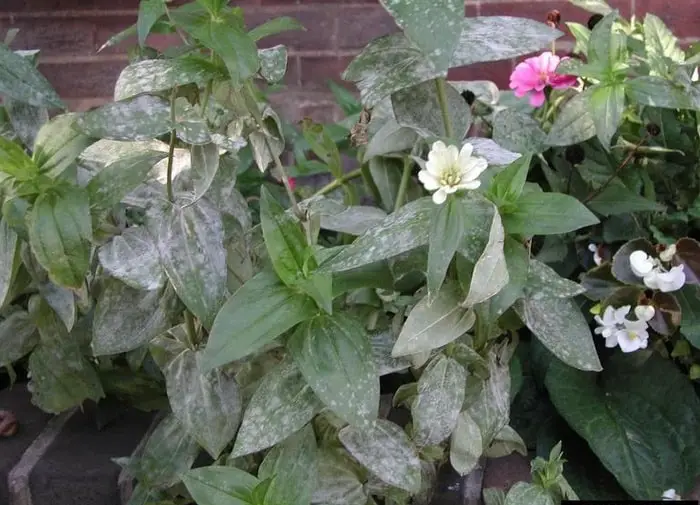Dianthus Leaves Turning White? Here’s How To Easily Fix It!
Are you noticing white patches on your Dianthus leaves? Don’t panic! While these white discolorations can be alarming, they are often a sign of a treatable issue. In this blog post, we’ll explore the common causes of Dianthus leaves turning white and provide you with helpful tips and tricks to get your plants looking healthy and vibrant again.
Dianthus leaves turning white can be caused by powdery mildew, nutrient deficiencies, pests, or improper soil pH. To treat white leaves, gardeners can adjust the soil pH, use natural or chemical treatments to control pests, and provide regular fertilization to prevent nutrient deficiencies.
| Why Are Dianthus Leaves Turning White |
|---|
| 1.Powdery Mildew |
| 2. Sunburn |
| 3. Unbalanced soil pH |
| 4. Nutrient Deficiencies |
| 5. Pests |
1. Powdery Mildew

Powdery mildew is the main factor why dianthus leaves are turning white. This fungus appears as a powdery white or gray coating on the dianthus leaves and stems, eventually causing them to dry out and turn white.
To identify powdery mildew on Dianthus leaves, look for the following symptoms:
- White, powdery patches on the upper surface of leaves.
- Distorted or stunted growth of affected leaves.
- Yellowing of leaves and premature leaf drop in severe cases.
- The powdery substance may also be present on stems and flowers.
As far as I know, powdery mildew penetrate the plants cells to extract nutrients, resulting in weakened plants and the loss of their color making the leaves appear white.
To thrive, powdery mildew prefers humid conditions with air circulation. It spreads from one dianthus plant to another through wind, rain or contact with plant material.
Gardeners can prevent powdery mildew infection in Dianthus plants by improving air circulation around them avoiding watering and placing them in lit locations. If an outbreak occurs, applying a fungicide to affected areas and removing leaves or stems will help prevent spread of the fungus.
Treatment
Here are effective methods to treat powdery mildew infestations:
- Pruning: Remove heavily affected leaves and stems immediately. Dispose of the pruned parts away from the garden to prevent spore spread.
- Fungicidal Spray: Apply a suitable fungicide as per the manufacturer’s instructions. Neem oil, horticultural oil, or fungicidal soaps can help combat mild infections.
- Baking Soda Spray: Create a natural fungicidal spray by mixing one tablespoon of baking soda, a few drops of dish soap, and one gallon of water. Spray this solution on the affected parts once a week.
Table with Dianthus varieties that are known to have some resistance to powdery mildew:
| Dianthus Variety | Tolerance to Powdery Mildew |
|---|---|
| Bath’s Pink | Moderate |
| Brilliant | High |
| Doris | Moderate |
| Firewitch | Moderate |
| Frosty Fire | Moderate |
| Memories | Low |
| Neon Star | High |
| Pink Kisses | High |
| Sweet William | Moderate |
| Zing Rose | High |
Please note that while these varieties are more resistant to powdery mildew, they are not completely immune. Gardeners should still monitor their plants regularly and take steps to prevent and address powdery mildew if it does occur.
2. Sunburn
Dianthus plants can experience sunburn when their leaves are exposed to sunlight, causing damage to the leaf tissues. If the sun’s rays are too strong they scorch the leaves of the dianthus, resulting in the formation of white patches or spots.
These white patches indicate areas where cells have died or been damaged losing their chlorophyll for leaf greenness. Consequently, these affected parts turn white and in some cases, the leaves may become crispy and eventually die.
Treatment
To protect Dianthus plants from the effects of sunlight while still promoting their growth, you can consider the following shading options:
- Natural Shade: Use existing shade sources like trees, taller plants or nearby structures to shield Dianthus plants from sunlight during this part of the day. However, make sure that the shading is not too dense as Dianthus still needs sunlight for growth and flowering.
- Shade Cloth: Install a shade cloth or garden fabric over your Dianthus bed to provide filtered sunlight. A shade cloth with a shading density of, around 30–50% will usually suffice for protecting Dianthus plants from sun exposure.
Consider utilizing shade structures like umbrellas, shade sails or lattice panels to provide shading for Dianthus plants during the suns peak hours.
3. Unbalanced soil pH
If the soil pH of Dianthus is imbalanced, it can result in white leaves due to the plant’s inability to absorb vital nutrients. Dianthus plants thrive in soil with a slightly acidic pH ranging from 6.0 to 7.0.
When the soil pH deviates from this range, nutrient deficiencies occur, hindering the plant’s mineral absorption capacity. This leads to the discoloration of dianthus leaves, turning them white or yellow.
Different nutrients have optimal availability within specific pH ranges. For example, iron (Fe) becomes less available to plants in alkaline soils, and manganese (Mn) becomes less available in acidic soils. Both iron and manganese are crucial for chlorophyll production and healthy leaf color.
If these nutrients are not readily available due to an improper pH, the leaves may develop interveinal chlorosis, appearing white or yellowish-white between the veins while the veins remain green.
For instance, excessively low soil pH (acidic) causes aluminum toxicity, resulting in stunted growth and pale leaves. Aluminum toxicity also disrupts calcium and magnesium absorption by the plant, and as a result, white, necrotic spots can appear.
Alternatively, if the soil pH is too high (alkaline), it results in iron and manganese deficiencies, which also cause leaf discoloration. In alkaline conditions, iron and manganese become less accessible to plants, causing green leaves to fade and turn white or yellow.
| Soil pH Level | Effect on Dianthus | Resulting Leaf Color |
|---|---|---|
| Too low (acidic) | Aluminum toxicity can occur, which can interfere with the plant’s ability to absorb calcium and magnesium | White or yellow |
| Too high (alkaline) | Iron and manganese deficiencies can occur, which can cause the leaves to lose their green color | White or yellow |
https://www.finegardening.com/article/the-four-things-you-need-to-know-about-soil-ph
Treatment
- Soil adjustments: You can add substances to your soil to balance its pH levels. For instance if the soil is too acidic I added lime to raise the pH. On the hand if the soil is too alkaline sulfur can be added to lower the pH. It’s crucial to carefully follow the instructions provided on the soil amendment package and regularly test your soils pH levels to ensure it remains within a range.
- Applying foliar sprays: Another approach I did take is using sprays that provide essential nutrients for Dianthus plants and address any nutrient deficiencies that might cause leaves to turn white.
For example iron or manganese based foliar sprays can help rectify deficiencies caused by high soil pH. You should be diligent, in following instructions found on the spray package and avoid spraying leaves during hot and sunny weather conditions.
4. Nutrient Deficiencies
When Dianthus plants lack nutrients, their leaves start turning white because it impairs their ability to produce chlorophyll.
Chlorophyll is responsible for the color of leaves and plays a crucial role in photosynthesis, the process through which plants convert sunlight into energy. Thus, if there is a shortage of chlorophyll, the plant can become weak.
| Nutrient | Deficiency Symptoms on Dianthus Leaves | Treatment |
|---|---|---|
| Magnesium | White patches | Apply magnesium sulfate (Epsom salt) or a fertilizer high in magnesium. |
| Calcium | Necrotic spots, white or yellowish | Apply gypsum or a calcium-rich fertilizer. |
| Zinc | White spots or streaks | Apply a zinc-rich fertilizer or foliar spray. |
| Manganese | White or yellowish spots | Apply a manganese-rich fertilizer or foliar spray. |
| Iron | Yellow or white between veins | Apply iron chelate or a fertilizer high in iron. |
For instance a shortage of magnesium can cause white patches on Dianthus leaves while an iron deficiency can lead to white areas between the veins. Several factors like soil quality, improper fertilization and pH imbalances can contribute to these deficiencies.
5. Pests
Two common pests that can cause the leaves of Dianthus plants to turn white are spider mites and aphids. Spider mites, are insects which feed on the undersides of the leaves, creating a speckled or patchy white appearance.
On the other hand, aphids are soft-bodied bugs that extract sap from the dianthus’s leaves and stems, resulting in a sticky white substance on the foliage.
Aphids
Aphids, these little insects have a soft body and love to suck sap from the leaves and stems of plants. This unfortunate feeding habit often leads to the presence of a white substance known as honeydew on Dianthus leaves. Interestingly, this sticky substance can attract pests like ants and even sooty mold.
Now here’s the trouble with aphids: their feeding weakens plants. Makes them more vulnerable to fungal infections. On top of that, their munching activity can cause the leaves to lose their green color and turn white.
The reason behind this change in color is that aphids actually remove chlorophyll, which’s responsible, for giving leaves their lovely green hue.
As if that wasn’t enough, aphids can also spread viruses to Dianthus plants. These viruses cause damage and contribute further to the white discoloration of the leaves.
Treatment
Here are some common methods to treat aphids:
- Water: A strong blast of water from a hose can dislodge aphids from the plant and help control their population. This method is best used for light infestations.
- Insecticidal soap: Insecticidal soap is a natural treatment that can be used to kill aphids on contact. I advise you to follow the instructions on the insecticidal soap package carefully and avoid spraying the leaves during hot, sunny weather.
- Neem oil: Neem oil is another natural treatment that can be used to kill aphids. From my experience, you should follow the instructions on the neem oil package carefully and avoid spraying the leaves during hot, sunny weather.
How to Prevent Dianthus Leaves from Turning White
Here are some tips and techniques to prevent and address white leaves on Dianthus:
- Keep an eye on soil pH: Dianthus plants thrive in acidic soil with a pH range of 6.0 to 7.0. To tackle this I advise you to regularly check the soils pH. Make necessary adjustments using soil amendments like lime or sulfur.
- Water wisely: Overwatering or allowing the soil to become excessively saturated can increase the chances of infections and pest attacks both of which can result in white leaves on Dianthus plants. Start to water your dianthus deeply while ensuring that there is a slight drying period between each watering session.
- Ensure nutrients: Inadequate nutrient supply can be a culprit behind white leaves on Dianthus plants. Make sure you are growing in soil which provide sufficient nutrients and opt for fertilizers rich in essential elements like magnesium, calcium, zinc, manganese and iron that Dianthus plants require.
- Monitor for pests: Pests such as aphids and spider mites can also be responsible for causing leaves on Dianthus plants. Regular monitoring is crucial so that any infestations can be detected on. If necessary gardeners can use soap or neem oil as effective measures to control these pests population.
- Perform Pruning and Deadheading: To prevent the spread of infestations and encourage the growth of foliage it is advisable to trim any infected leaves or stems. Regular pruning is also beneficial as it promotes the growth of healthy foliage while mitigating fungal infections or pest infestations.
By following these tips and incorporating them into your gardening routine you’ll have success, in preventing and addressing white leaves on your Dianthus plants.




